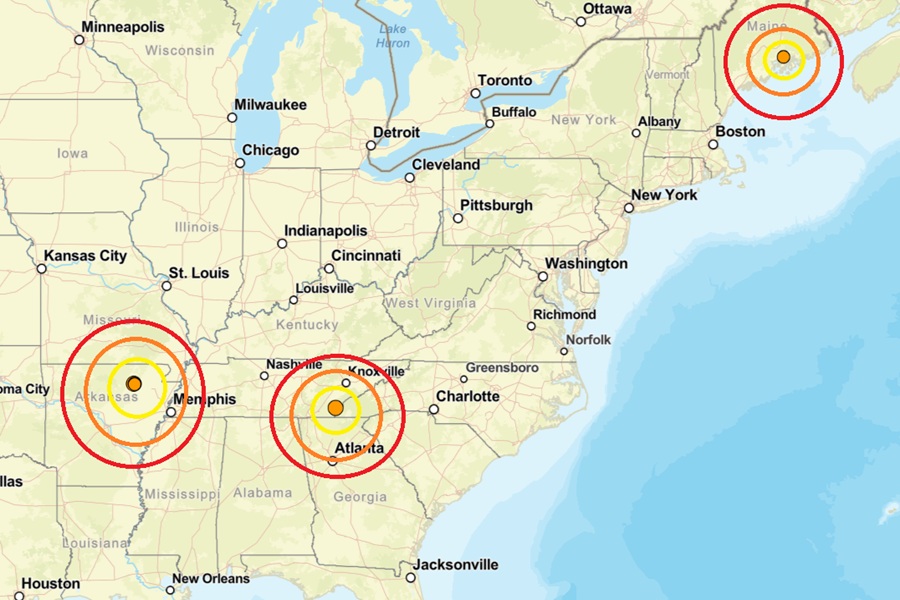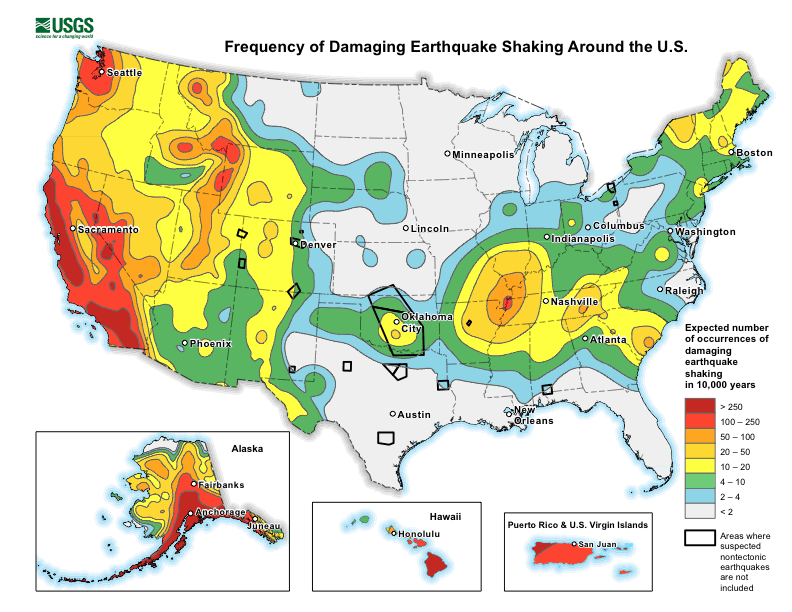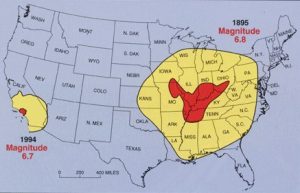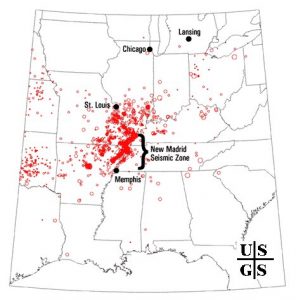
USGS has reported that weak earthquakes have struck Maine, Arkansas, and Tennessee, adding to a string of earthquakes that have struck New Jersey and Massachusetts in recent days. None of these new earthquakes have caused any damage nor injuries but serve as a reminder of ongoing earthquake threats in the U.S. far from the West Coast.
The Maine earthquake struck at 10:12 pm last night near Penobscot on the central Maine coast, just northwest of Acadia National Park. The weak magnitude 1.4 event struck from a depth of 11.6 km.
The Tennessee earthquake, a magnitude 2.2 event, struck 9:04 am this morning from a depth of 12.4 km near Tellico Plains. Tellico Plains is located in far eastern Tennessee not far from the state lines with North Carolina and Georgia just west of Chattanooga.
Three separate earthquakes struck Arkansas today within minutes of each other. Striking within 3 miles of each other in Strawberry, located northeast of Little Rock, Arkansas and northwest of Memphis, Tennessee, the first struck at 7:28 am, the second struck at 7:34 am, and the third struck at 7:50 am.
USGS says that earthquakes with a magnitude of 2.0 or less are rarely felt or heard by people, but once they exceed 2.0 , more and more people can feel them. While damage is possible with magnitude 3.0 events or greater, significant damage and casualties usually don’t occur until the magnitude of a seismic event rises to a 5.5 or greater rated event.

According to USGS, people in New England have felt small earthquakes and suffered damage from infrequent larger ones since colonial times. Moderately damaging earthquakes strike somewhere in the region every few decades, and smaller earthquakes are felt roughly twice a year. The Boston area was damaged three times within 28 years in the middle 1700’s, and New York City was damaged in 1737 and 1884. The largest known New England earthquakes occurred in 1638 with a magnitude 6.5 in Vermont or New Hampshire, and in 1755 when a magnitude 5.8 earthquake struck offshore from Cape Ann northeast of Boston. That Cape Ann earthquake caused severe damage to the Boston waterfront.
While the northeast has had significant earthquakes in the past, an even more significant series of earthquakes struck in an area known as the New Madrid Seismic Zone, or NMSZ for short. Today’s earthquakes in Arkansas are close to the NMSZ.
December 16 marks the anniversary of first of three very significant earthquakes to strike this same region during the winter of 1811-1812, a violent time in seismological history of the region that scientists say will be repeated again. While this latest earthquake was relatively inconsequential, authorities are concerned that people aren’t properly prepared for when a big earthquake will strike this region. The matter of a larger destructive earthquake in this area is more of a matter of “when” rather than “if.” These recent earthquakes have been in the heart of the NMSZ where a significant earthquake will likely happen again at some point in the future.
While the US West Coast is well known for its seismic faults and potent quakes, many aren’t aware that one of the largest quakes to strike the country actually occurred near the Mississippi River. On December 16, 1811, at roughly 2:15am, a powerful 8.1 quake rocked northeast Arkansas in what is now known as the New Madrid Seismic Zone. The earthquake was felt over much of the eastern United States, shaking people out of bed in places like New York City, Washington, DC, and Charleston, SC. The ground shook for an unbelievably long 1-3 minutes in areas hit hard by the quake, such as Nashville, TN and Louisville, KY. Ground movements were so violent near the epicenter that liquefaction of the ground was observed, with dirt and water thrown into the air by tens of feet. President James Madison and his wife Dolly felt the quake in the White House while church bells rang in Boston due to the shaking there.
But the quakes didn’t end there. From December 16, 1811 through to March of 1812, there were over 2,000 earthquakes reported in the central Midwest with 6,000-10,000 earthquakes located in the “Bootheel” of Missouri where the New Madid Seismic Zone is centered.
The second principal shock, a magnitude 7.8, occurred in Missouri weeks later on January 23, 1812, and the third, a 8.8, struck on February 7, 1812, along the Reelfoot fault in Missouri and Tennessee.

The second principal shock, a magnitude 7.8, occurred in Missouri weeks later on January 23, 1812, and the third, a 8.8, struck on February 7, 1812, along the Reelfoot fault in Missouri and Tennessee.
The main earthquakes and the intense aftershocks created significant damage and some loss of life, although lack of scientific tools and news gathering of that era weren’t able to capture the full magnitude of what had actually happened. Beyond shaking, the quakes also were responsible for triggering unusual natural phenomena in the area: earthquake lights, seismically heated water, and earthquake smog.

Residents in the Mississippi Valley reported they saw lights flashing from the ground. Scientists believe this phenomena was “seismoluminescence”; this light is generated when quartz crystals in the ground are squeezed. The “earthquake lights” were triggered during the primary quakes and strong aftershocks.
Water thrown up into the air from the ground, or the nearby Mississippi River, was also unusually warm. Scientists speculate that intense shaking and the resulting friction led to the water to heat, similar to the way a microwave oven stimulates molecules to shake and generate heat. Other scientists believe as the quartz crystals were squeezed, the light they emit also helped warm the water.
During the strong quakes, the skies turned so dark that residents claimed lit lamps didn’t help illuminate the area; they also said the air smelled bad and was hard to breathe. Scientists speculate this “earthquake smog” was caused by dust particles rising up from the surface, combining with the eruption of warm water molecules into the cold winter air. The result was a steamy, dusty cloud that cloaked the areas dealing with the quake.
The February earthquake was so intense that boaters on the Mississippi River reported that the flow of the water there reversed for several hours.
The area remains seismically active and scientists believe another strong quake will impact the region again at some point in the future. Unfortunately, the science isn’t mature enough to tell whether that threat will arrive next week or in 50 years. Either way, with the population of New Madrid Seismic Zone huge compared to the sparsely populated area of the early 1800s, and tens of millions more living in an area that would experience significant ground shaking, there could be a very significant loss of life and property when another major quake strikes here again in the future.